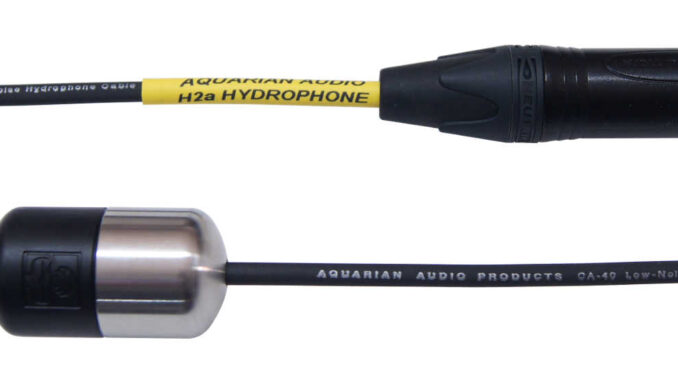
Have you ever wondered what lies beneath the ocean’s surface, beyond the visual realm? The vast expanse of the sea teems with life, and the sounds these creatures produce paint a captivating sonic portrait. But how do we listen to this hidden symphony? Enter the hydrophone, a specialized microphone designed to capture the sounds of the underwater world.

Hydrophones
Unlike our standard microphones that translate air vibrations into electrical signals, hydrophones are built for a different medium. Water conducts sound waves much faster and with different properties than air. A standard microphone wouldn’t be able to withstand the pressure or interpret the sound waves accurately.
Hydrophones are meticulously crafted to function effectively underwater. They typically consist of a piezoelectric element, a material that converts pressure changes into electrical signals. When sound waves travel through the water and strike the hydrophone, this element vibrates, generating an electrical signal that can be recorded.
There are two main types of hydrophones: omnidirectional and directional. Omnidirectional hydrophones capture sound equally from all directions, ideal for recording ambient soundscapes or calls from unknown locations. Directional hydrophones, on the other hand, focus on sound from a specific direction, allowing researchers to isolate the calls of specific animals like whales or dolphins.
Hydrophones play a crucial role in various fields. Marine biologists use them to study communication patterns of marine mammals, understand their behavior, and even monitor their population health. Oceanographers utilize hydrophones to investigate underwater acoustics, map the ocean floor, and even detect human activity’s impact on marine life.
As technology advances, hydrophones become more sophisticated and robust. They are opening doors to a deeper understanding of the ocean’s hidden world, allowing us to listen to the symphony of the deep and gain a newfound appreciation for the delicate balance of this underwater ecosystem.
5 Most Popular Hydrophones
Here are 5 most popular hydrophones used for underwater recording:
- Compact and Affordable Omnidirectional Hydrophones: These are ideal for beginners or hobbyists recording in freshwater environments. They are typically small, lightweight, and user-friendly. (Examples: Aquarian Audio Hydrophones, DPA 4007 Hydrophone)
- Directional Hydrophones: These focus on sound from a specific direction and are used by researchers to study vocalizing marine life like whales and dolphins. They are often more expensive than omnidirectional models. (Examples: Wildlife Acoustics Song Meter MH2, Sonotronics DM2 Directional Microphone)
- Hydrophone Arrays: These consist of multiple hydrophones arranged in a specific pattern. They offer advantages like improved signal-to-noise ratio and better sound localization. (Examples: Vemco Hussar Net, Teledyne Benthos PSA-9116 Hydrophone Array)
- Specialty Hydrophones: These are designed for specific applications, such as high-pressure environments or capturing low-frequency sounds. They cater to advanced users and scientific research. (Examples: Reson FT-100 Free-Fall Hydrophone, Oceanic Imaging icListen HF Hydrophone)
- Budget-Friendly Kits: Some manufacturers offer starter kits that include a hydrophone, cable, and recorder – a good option for those getting started with underwater recording. (Examples: Rode NT-USB Mini Underwater Recording Kit, AKG Perception Underwater Recording Kit (discontinued))
How Far Can A Hydrophone Hear?
The distance a hydrophone can “hear” underwater depends on several factors, making it difficult to give a single, definitive answer. Here’s a breakdown of the key influences:
- Frequency of the Sound: Lower frequency sounds travel farther underwater than higher frequencies. A hydrophone designed to capture whale calls (typically low-frequency) will have a greater range than one used for dolphin clicks (higher frequency).
- Water Conditions: Factors like salinity, temperature, and presence of marine life can affect sound propagation. Calmer, less-turbid water allows sound to travel farther.
- Background Noise: Ocean currents, wave action, and even biological noise from marine organisms can mask the sounds you’re trying to capture. A quieter environment translates to a longer effective range.
- Hydrophone Sensitivity: More sensitive hydrophones can pick up weaker sounds from greater distances.
Considering these factors, here’s a general range for hydrophone detection:
- Low-frequency sounds (whale calls): Up to several kilometers (a few miles)
- Mid-frequency sounds (boat engines): Hundreds of meters to kilometers
- High-frequency sounds (dolphin clicks): Tens to hundreds of meters
Important Note: These are just estimates. The actual distance a hydrophone can effectively hear will vary depending on the specific circumstances.
Here are some additional points to consider:
- Hydrophone Arrays: Using multiple hydrophones in an array can improve sound localization and potentially increase the effective range for specific sounds.
- Signal Processing: By amplifying and filtering the desired sound frequencies, researchers can sometimes pull faint sounds from the background noise, extending the effective range of the recording.
Overall, hydrophones are powerful tools for underwater listening, but the distance they can effectively “hear” is a complex issue influenced by various environmental factors and the specific sounds being targeted.
Popular Posts:
Stylophone Tabs
Banjo Tabs
Dulcimer Tabs
Kalimba Tabs
Mandolin Tabs
